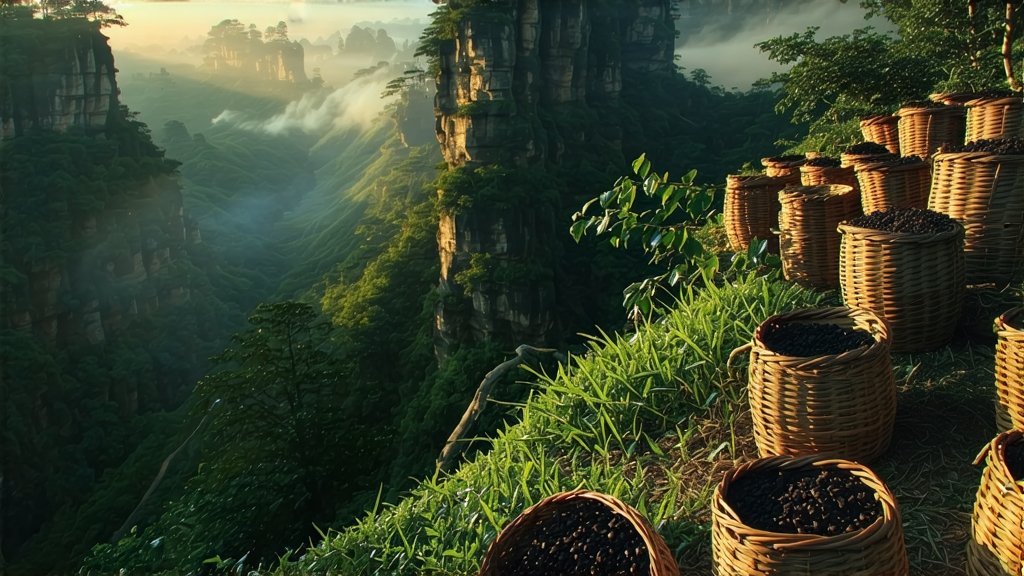
Ask most tea lovers to name China’s oldest black tea and they will answer, without hesitation, Lapsang Souchong. Born in the precipitous Wuyi Mountains of northern Fujian around 1568, this leaf is the progenitor of every black tea on earth; the very word “bohea,” coined by seventeenth-century Dutch traders, is a corruption of “Wuyi.” Yet Lapsang Souchong is no museum relic. In the cup it remains defiantly alive—wine-dark, incense-sweet, and wrapped in a perfume of smouldering pine that can transport the drinker from a London study to a misty Chinese fir forest in a single sip.
History: From Bandit Trail to Global Craving
Legend credits the creation to a passing army that camped in Tongmu village during the late Ming dynasty. The soldiers commandeered tea sheds for the night, forcing farmers to delay leaf processing until dawn. To rescue the already wilted leaves from spoilage, the villagers rushed them over open pinewood fires. The resulting tea, far from ruined, carried an alluring smokiness and kept its flavour on the long overland trek to the Russian border. By 1604 Dutch merchants had ferried it to Europe, where Catherine of Braganza’s marriage to Charles II made it fashionable at the English court. Within decades bohea outsold green tea in London auctions, financed New York dockyards, and inspired the Boston Tea Party chests stamped with the single word “Souchong.”
Micro-Terroir: Why Only Tongmu Tastes of Tongmu
Authentic Lapsang Souchong comes from a 600–1,200 m core zone inside Wuyi’s national reserve, a UNESCO mixed heritage site. Here, a subtropical monsoon climate collides with mineral-rich Jurassic granite soils. Day-night temperature swings of 15 °C slow leaf growth, concentrating polyphenols and sweet amino acids. Indigenous Xingcun Xiaozhong cultivars, kept as small trees rather than bushes, send roots into cracks of weathered rock, absorbing trace elements that translate into a signature “yan yun” or rock rhyme—a lingering coolness felt at the back of the throat. Because the reserve bans outside tea or wood from entering, every kilo of genuine Tongmu leaf is traceable to a family plot averaging less than 0.3 hectares.
Leaf Grades: From Souchong to Jin Jun Mei
Although Western catalogues lump everything under “Lapsang,” locals recognise a sliding scale of leaf quality:
• Souchong—third leaf down, 1–2 cm, lightly twisted, classic pine-smoke note.
• Pekoe Souchong—second leaf, golden tips visible, smoke more subdued.
• Congou (Gongfu) Souchong—first two leaves and a bud, fully smoked yet balanced.
• Jin Jun Mei—an invention of 2005, only buds, no smoke, honey and longan aromatics.
• Yin Jun Mei—one bud and one leaf, trace smoke, cacao finish.
Each grade is processed in the same 250-year-old sequence, yet the proportion of bud, withering time, and smoking depth differ, yielding a spectrum from campfire swagger to silky dessert wine.
Craft: Eight Steps on the Edge of Ruin
- Plucking: Dawn mist still clings when pickers break the standard “two leaves and a bud” rule, selecting thicker Wuyi spring material that can withstand heavy smoke.
- Solar Withering: Leaves are laid on bamboo screens tilted toward the rising sun for 30–40 minutes, driving off surface moisture while beginning enzymatic oxidation.
- Indoor Withering: Moved into the upper floor of a three-storey wooden house, the leaf piles are alternately fluffed and rested for 4–6 hours until 60 % moisture loss and a grassy note gives way to apple-skin sweetness.
- Rolling: A 55-year-old cast-iron treadle machine cracks cell walls just enough; over-rolling would turn smoke harsh.
- Oxidation: In a pine-sealed room kept at 24 °C and 80 % humidity, leaves rest 2–3 hours, turning from jade to copper to dark mahogany. Mastery lies in stopping the reaction the moment a bronze rim appears on the sample leaf.
- Pan-firing: A 220 °C wok arrests oxidation in 90 seconds, locking in malt